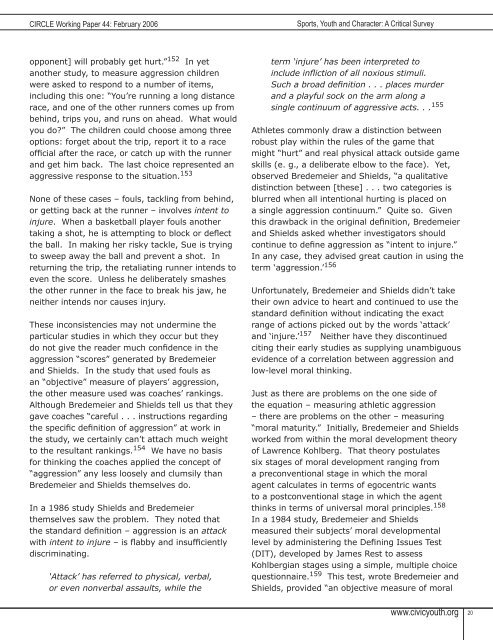The All-Sports Ministry of PA NJ & DE - Executive Summary Start-Up Budget & Prospectus
The All-Sports Ministry of PA NJ & DE - Executive Summary Start-Up Budget & Prospectus
The All-Sports Ministry of PA NJ & DE - Executive Summary Start-Up Budget & Prospectus
Create successful ePaper yourself
Turn your PDF publications into a flip-book with our unique Google optimized e-Paper software.
CIRCLE Working Paper 44: February 2006<br />
<strong>Sports</strong>, Youth and Character: A Critical Survey<br />
opponent] will probably get hurt.” 152 In yet<br />
another study, to measure aggression children<br />
were asked to respond to a number <strong>of</strong> items,<br />
including this one: “You’re running a long distance<br />
race, and one <strong>of</strong> the other runners comes up from<br />
behind, trips you, and runs on ahead. What would<br />
you do?” <strong>The</strong> children could choose among three<br />
options: forget about the trip, report it to a race<br />
<strong>of</strong>ficial after the race, or catch up with the runner<br />
and get him back. <strong>The</strong> last choice represented an<br />
aggressive response to the situation. 153<br />
None <strong>of</strong> these cases – fouls, tackling from behind,<br />
or getting back at the runner – involves intent to<br />
injure. When a basketball player fouls another<br />
taking a shot, he is attempting to block or deflect<br />
the ball. In making her risky tackle, Sue is trying<br />
to sweep away the ball and prevent a shot. In<br />
returning the trip, the retaliating runner intends to<br />
even the score. Unless he deliberately smashes<br />
the other runner in the face to break his jaw, he<br />
neither intends nor causes injury.<br />
<strong>The</strong>se inconsistencies may not undermine the<br />
particular studies in which they occur but they<br />
do not give the reader much confidence in the<br />
aggression “scores” generated by Bredemeier<br />
and Shields. In the study that used fouls as<br />
an “objective” measure <strong>of</strong> players’ aggression,<br />
the other measure used was coaches’ rankings.<br />
Although Bredemeier and Shields tell us that they<br />
gave coaches “careful . . . instructions regarding<br />
the specific definition <strong>of</strong> aggression” at work in<br />
the study, we certainly can’t attach much weight<br />
to the resultant rankings. 154 We have no basis<br />
for thinking the coaches applied the concept <strong>of</strong><br />
“aggression” any less loosely and clumsily than<br />
Bredemeier and Shields themselves do.<br />
In a 1986 study Shields and Bredemeier<br />
themselves saw the problem. <strong>The</strong>y noted that<br />
the standard definition – aggression is an attack<br />
with intent to injure – is flabby and insufficiently<br />
discriminating.<br />
‘Attack’ has referred to physical, verbal,<br />
or even nonverbal assaults, while the<br />
term ‘injure’ has been interpreted to<br />
include infliction <strong>of</strong> all noxious stimuli.<br />
Such a broad definition . . . places murder<br />
and a playful sock on the arm along a<br />
single continuum <strong>of</strong> aggressive acts. . . 155<br />
Athletes commonly draw a distinction between<br />
robust play within the rules <strong>of</strong> the game that<br />
might “hurt” and real physical attack outside game<br />
skills (e. g., a deliberate elbow to the face). Yet,<br />
observed Bredemeier and Shields, “a qualitative<br />
distinction between [these] . . . two categories is<br />
blurred when all intentional hurting is placed on<br />
a single aggression continuum.” Quite so. Given<br />
this drawback in the original definition, Bredemeier<br />
and Shields asked whether investigators should<br />
continue to define aggression as “intent to injure.”<br />
In any case, they advised great caution in using the<br />
term ‘aggression.’ 156<br />
Unfortunately, Bredemeier and Shields didn’t take<br />
their own advice to heart and continued to use the<br />
standard definition without indicating the exact<br />
range <strong>of</strong> actions picked out by the words ‘attack’<br />
and ‘injure.’ 157 Neither have they discontinued<br />
citing their early studies as supplying unambiguous<br />
evidence <strong>of</strong> a correlation between aggression and<br />
low-level moral thinking.<br />
Just as there are problems on the one side <strong>of</strong><br />
the equation – measuring athletic aggression<br />
– there are problems on the other – measuring<br />
“moral maturity.” Initially, Bredemeier and Shields<br />
worked from within the moral development theory<br />
<strong>of</strong> Lawrence Kohlberg. That theory postulates<br />
six stages <strong>of</strong> moral development ranging from<br />
a preconventional stage in which the moral<br />
agent calculates in terms <strong>of</strong> egocentric wants<br />
to a postconventional stage in which the agent<br />
thinks in terms <strong>of</strong> universal moral principles. 158<br />
In a 1984 study, Bredemeier and Shields<br />
measured their subjects’ moral developmental<br />
level by administering the Defining Issues Test<br />
(DIT), developed by James Rest to assess<br />
Kohlbergian stages using a simple, multiple choice<br />
questionnaire. 159 This test, wrote Bredemeier and<br />
Shields, provided “an objective measure <strong>of</strong> moral<br />
www.civicyouth.org 20

















